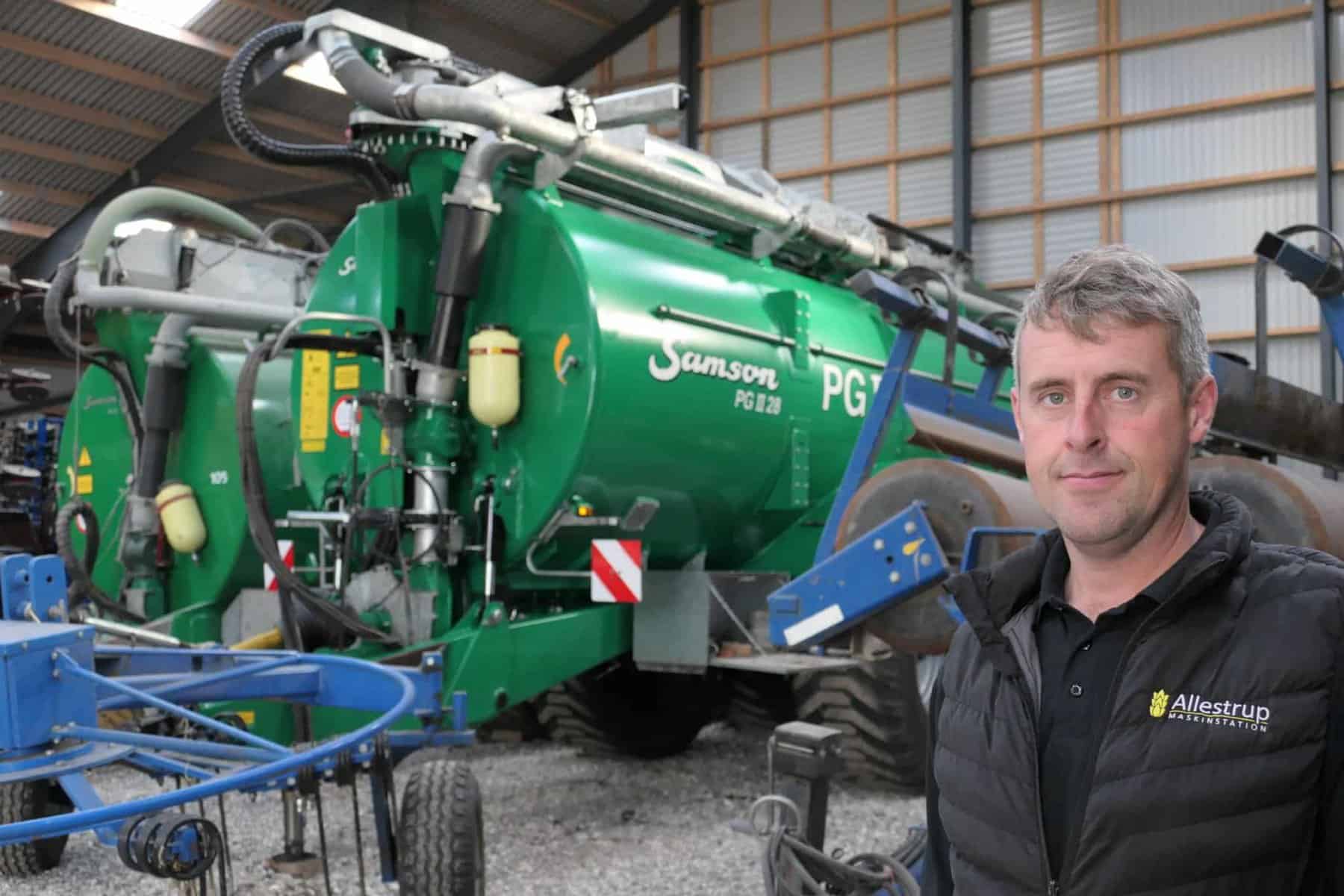
This is where the SAMSON PG II 25 slurry tanker with PTO shaft is most useful, says machine operator Alexander Jakobsen from Allestrup Maskinstation between Hobro and Aars.
As always, Alexander Jakobsen drives in set lanes at the contracting company's many customers. And it's part of Allestrup Maskinstation's service that there should be no visible traces in the field after adding 25 tons of slurry per hectare to boost the yield of the next crop.
Machine operator Alexander Jakobsen, Allestrup Maskinstation, shows how an extra track width of 800 millimeters on each side protects the sward and eliminates rutting, even in wet soil.
If it's an old grassland with firm and clear tracks, I don't push the axle out, because there's often nothing to be gained by widening the track," explains the experienced and farmer-trained machine operator.
On the three-axle SAMSON PG II 25 slurry tanker, the ejector shaft is located in the middle.
When I turn into the field and find the track, I activate the ejection axles, which slowly and synchronously extend 800 millimeters to both sides, doubling the track width and the part of the field where the load is distributed," explains Alexander Jakobsen, who with a glance in the mirrors always has the function under control.
- Discreet and effective. When working in the field, the SAMSON ejector axle doubles the track width of the slurry tanker and distributes the load over a total track width of 3.2 meters.
Even when the axle needs to be pushed back in line with the other wheels, it also happens while the vehicle is rolling.
These are powerful pistons that can easily push up a pile of dirt if the wheels are pushed out while I'm stationary. The ejector shaft carries as much as the other two shafts, he explains.
At home at Allestrup Maskinstation, owner Henrik Nielsen explains his reasons for acquiring a slurry tanker with an external axle.
This is actually the closest we get to a self-driving slurry tanker. With the eccentric shaft, we distribute the pressure over twice the area. Just like you do with a self-driving slurry truck with a dogwalk, he points out.
Allestrup Maskinstation has seven SAMSON slurry trailers, of which there are also two wheeled tractors that are particularly useful on hilly areas. The SAMSON wagon with an extension axle is mainly used when spreading slurry on grassland fields.
In addition to distributing the load over a wider track, it's important that no edges of soil are pushed up the sides of the track when we spread slurry on the grass, he explains.
Henrik Nielsen, who has run his contracting company from the address since 2005, has extensive experience of all the grass silage processes that one of the company's three cutting teams is kept busy with over the summer.
We know how a heavy slurry tanker in wet soil right after a cut can sometimes create small mounds of soil at the edge of the track. It bothers both the swather and the rake and can ultimately contribute to carrying soil into the grass silage, which we don't want. And it just so happens that the day when it's best to spread slurry and when we get the best nutrient utilization is also the day when the soil is wet," he points out.
- Especially in freshly cut grass fields, a SAMSON output shaft can protect the grass by distributing loads over a larger track width. It is important that there are no trailing edges where swathers and rakes can drag soil into the silage.
The contracting company also experiences customers who ask for slurry to be delivered with the truck that has an external axle.
It's when a field has unfortunately gotten a little too high on the tracks. In some situations, we can press the edges down again in the same workflow so they don't bother you later in the season," he explains.
Henrik Nielsen has gained a lot of experience with slurry spreading. Including self-driving systems with dogwalk that can distribute ground pressure in wider lanes.
But we need to look at the cost of slurry delivery, which is why today I only use tractor-drawn solutions. Already in 2005 I had a trolley with an external axle. But back then, the wheels could only be pushed out half as far. Today, we use 800-millimeter tires and the axle is extended by 800 millimeters," he says.
Today, Henrik Nielsen has 7 slurry trailers, 4 25-ton and 3 28-ton slurry trailers and a single truck for moving slurry.
85 percent of the slurry is picked up directly from the tank with the trucks and only about 15 percent of the slurry is transported to the field with the truck. On the other hand, the truck moves a lot of slurry during the year. In general, we use a 24 meter system and almost all customers have fixed lanes in the hayfields.
As mentioned, we have 2 trolleys with wheel drive and it makes sense around here, where there are a lot of hills. The fact that the price is only a third of the additional cost of a wheel drive trolley is also a factor in our decision to buy a trolley with an external axle. And I hope customers will appreciate the situations where the quality of slurry delivery improves when it's done with a truck with an external axle," he says.
Monday – Thursday:
07.00 – 16.00
Friday
07.00 – 15.00
Petersmindevej 6, DK-8800 Viborg
VAT no. 10963230

Copyright © 2024 Samson Agrolize